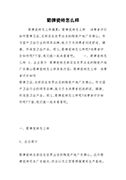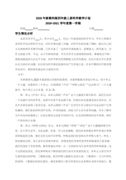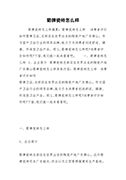《In class》教学设计(精选2篇)四年级英语教案
《In class》教学设计(精选2篇)
《In class》教学设计 篇1
第一课时
一、教学目标
通过教学,引导学生学会用英文表达自己对不遵守规矩的人的态度;能熟练使用目标语言谈论某些规章制度;能使用目标语言讨论校园内一些公共场合的规则。
1.认知目标:
· 重点词汇:in class, classroom, hallway, gym, arrive late, go out, practice, inside, outside, uniform, sneakers, fight, can, can't, have
· 重点句型:
don't eat in class!
can we wear hats? no, we can't.
we don't have to wear a school uniform.
· 语言结构:① 祈使句 ② 情态动词 can 表示许可的用法。
2.能力目标:
· 培养语言运用能力,让学生把所学到的语言知识和生活实际联系起来,使学习过程生活化。
· 培养用英语思维的能力和创新意识。
· 学会不断发现问题和分析问题,并用自己已有的知识水平和生活经历来解决实际问题。
3.情感目标:
· 通过小组对话、讨论和调查等一系列的活动,培养学生的合作意识。
· 通过课堂上与外教的交流,让学生了解不同的国家的不同的文化,培养初步的跨文化交际能力。
4.德育目标:
· 促进学生养成良好的行为习惯和在良好的道德品质。
二、教学过程
step one:lead in
1. greet with the students by using “good morning, boys and girls.”
2.show the students a picture and revise “what is he/she doing?” by asking questions.
t: look at this girl. what is she doing?
s: she is eating an apple.
t: can we eat an apple in class?
s: no, we can't.
t: so what should we say to the girl.
t: we should say to the girl :“don't eat apples in class.”
then point out the other students in the picture and say, each of these students is breaking one of the school rules. so what should we say to them?
根据这样的对话,把图片中其他学生不应该在课堂上出现的行为一一列出来, 并且用祈使句的句型排列在黑板上:
don't arrive late for class.
don't run in the hallways.
don't listen to music in the classroom.
don't fight.
3. read the list to class. then ask the students read the list again.
4. two foreign teachers of our school act out some rules to make clear the meaning of each one. for example: a foreign teacher is pretend to listen to music in class. then encourage students to say something to him. “can we listen to music in class? if you see someone do that, what should you say to him?” “don't listen to music in class!”
邀请我校的外教的参与到课堂中,做出一些违反课堂纪律的事情,引导学生用所学的句型指出他们的错误。外教生动的表演极大的调动了学生的积极性,学生马上能够大胆的运用目标语言指出他们做得不对的地方。如:不要在课堂上听音乐。
step two:listening
1. point t o the picture in activity 2a. asking students to tell what they are doing.( they are talking school rules.)
2. play the recording, ask the students to put a checkmark next to the activities they are talking about.
3. play the recording again. point out the list of can and can't in the chart in activity 2a. students listen and circle the answers.
通过听力训练,让学生能够对今天课堂上所学的目标句型有敏感的反应,并能够在下一个任务环节中熟练地应用。
step three: discussion
make a list of school rules and give students a form like this:
activities
in our school
in england
in holland
listen to music in the classroom
can’t
eat in the classroom
fight with others
keep long nail
throw away the rubbish
speak loudly in the library
……
1. ask the students think about the school rules in the form, what we can do or what we can’t do in our school. then discuss the answers with their partners in groups.
2. introduce two foreign teachers to the students. one is from england, the other is from holland. encourage the students to ask them questions, and then discuss how rules of our school are different from those of england and holland schools.
这是一个巩固性的活动,要求学生能运用目标语言进行真实的交际。邀请我校的两名分别来自英国和荷兰的外教参与课堂教学,鼓励学生向他们提问,了解同样的校规在不同的国家和学校有什么不一样的规定。同时也使学生养成良好的运用英语的习惯。
step four:introduce your opinion
通过与外教交流,各小组根据自己所获得的信息,分析同样的校规在不同的国家和学校的不同之处,然后充分运用所学语言,向全班作汇报。
for example: we can't listen to music in class, and the students in england can't, either. but the students in holland can listen to music in class.
课后反思:
本单元的教学内容较多,而且非常生活化,所以针对不同的内容设计了不同的任务活动。通过课堂的试验,证实了这些任务的可行性,并达到了意想不到的效果。
1.在导入新知识时,通过复习旧的句型很自然、顺利的进入目标句型的教学。
2.在第一个任务中,外教的加入就像是兴奋剂,而且他们生动的肢体语言极大的调动了学生的积极性。学生马上能够大胆的运用目标语言指出他们做得不对的地方。
3.第二个任务是由学生根据老师提供的一些描述行为的词语,与外教交流,学生为达成这一任务,就必须大胆提问,而且也迫使学生养成良好的运用英语的习惯。
本节课的不足之处,由于在学生提问的环节上学生的自主性强,这样胆子大的,英语好的学生就表现突出,获得的锻炼就相对应多;对于英语表达能力差的学生,老师照顾不够,得到的锻炼相对少。所以在以后的教学中还应不断的探索,寻求更大的突破。
教案点评:
根据本节课的教学目标,老师给学生设计了话题,给学生一个平台,让学生在这个平台上进行学习,而不是让学生没有范围的进行讨论,突出了教学重点,也达到了教学的认知目标。同时老师能够充分利用学校的外教资源,由于外教的参与,一个是提高了学生的学习兴趣,另一个迫使学生用英语进行交流,养成良好的运用英语的习惯。而且我们也看到,在整节课中,学生都是在一种愉快,积极的氛围中学习,体现了课改中使语言学习的过程成为学生形成积极的情感态度、主动思维和大胆实践,提高跨文化的意识和形成自主学习能力的过程的这一要求。
《In class》教学设计 篇2
一.教学要求:
1.能听得懂、会说、会读和会拼写单词eat ,drink ,close ,open .
2. 能在适当的场合正确运用祈使句。
3.能听得懂、会说和会读日常交际用语that’s all right .don’t be late again .
二、教学重点:
1.能听得懂、会说、会读和会拼写单词eat ,drink , close,open .
2.能在适当的场合正确使用祈使句。
三、教学难点:
1.能听得懂、会说、会读和会拼写单词eat ,drink, close ,open.
2. 能在适当的场合正确使用祈使句。
四、教具准备:图片、录音、教学挂图
五、教学理念
1.面向全体学生,突出学生主体。教学要面向全体学生,关注每个学生, 让每个学生都有机会练习说话。
2.整体设计目标,体现灵活开放。
3.任务型的教学模式。采用活动途径,通过体验、实践、讨论、合作、探究等方式发展学生的语言综合水平。
六、教学过程
一.greetings
二.sing an english song.《go to school》
三. presentation
1.(1)(安排一生迟到)s:sorry, iˊm late
t: that′s all right . come in ,please .
s:thank you ,miss zhang .
教学: sorry . i′mlate . (板书)
ss 开火车读.
t:that′s ok/ that′s all right
教学: that′s all right. (板书)
t:,don′t be late ,again s:all right/ok.
teach : don′t. again
(2)practice:
a: sorry , i′mlate
b: that′s all right. don′t be late again.
a: yes/ok
2.t:todaywe′ll learn a new unit-unit 8.in class.
now ,we′re in class .can you tell me the meaning of “in class”
s:在上课
t:wonderful! ok .look ,what′s this in english?
s:it′s a box .do you know what′s in the box? please guess .
ss guess
t: who can come here and open it ?
s:i can .
t: ,open the box . look . it′s an apple .
now , iˊm eating this apple .boys and girls , eat ,eat .eat an apple.
ss eat an appe.
t:now , don′t eat the apple . put your apple in the desk.
, close the box ,please .
3.t:here′s another box .please open the box and tell uswhat′s that ?
s: some milk
t:oh , iˊm thirsty . iˊll drink some milk.
boys and girls ,drink,drink,drink some milk.
t:now , ,close the box ,please .
who can read these sentenes ?
open the box.
close the box.
eat an apple.
drink some milk .
ss make the phrases.
4.chant .
5.教师奖励每组学生一个苹果(在黑板上)
t: i can draw an apple for you .
s: thank you .
t:can you draw a flower for me ?
s:yes .
teach and read : draw
6. play a game :simonsays
四.homework
1. read the new words and the dialogue after the tape .
2. copy the new words for three times
板书
unit 8 in class
a: sorry , iˊm late .
b: that′s all right.
don′t be late again .
a: yes/all right .
openthe box
close the box
eat .an apple
drink some milk
牛津英语4a unit 8 《in class》 教案(第一课时) 来自98e范文网。














